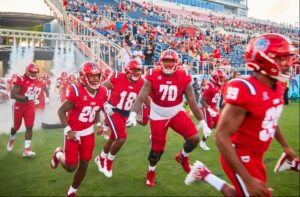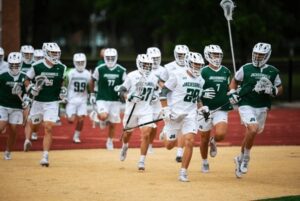I have taught statistics for many years and have always found that everyday examples help to illustrate points better than technical jargon or equations with Greek symbols. I think the same might be true for thinking about people strategies–let’s see. It occurred to me recently that sports teams, specifically (American) football and lacrosse teams, are great examples of two very different people strategies that an organization might adopt.
While I won’t spend a lot of time discussing these two sports, it is important to note that they have certain similarities that make the comparison potentially more valid. For example, the teams are roughly the same sizes with 10 and 11 players on the field (when at full strength), they play four 15-minute quarters/periods, have fields that are roughly the same size, and are full-contact. The numbers back this insight. Let’s review and consider the data from a university not selected at random.
The following are data and a chart derived from the University of North Carolina’s 2023 football and lacrosse team rosters (weight is in pounds):
So, a quick review of the data reveals that lacrosse players tend to be lighter than football players. Although, that’s not particularly surprising or interesting to note–the standard deviation and range are much more interesting. The standard deviation for football players is 3 times that of the lacrosse team. The range for football player weight is larger than the weight of some of the players on the team. So, lacrosse players physically are quite similar in stature while football players vary widely…what does this have to do with people strategies? Well, everything! Let’s look at one more set of data tables, with the average weight by position arranged from heaviest to lightest.
These charts provide three additional insights.

First, there are nearly twice as many positions on a football team. Second, the average weight differences by position can be quite large on a football team. For example, the two most common positions on this team–wide receiver and offensive lineman–have average weights that are 121 pounds apart. The two most common positions on this Lacrosse team–midfielders and defenseman–have only a difference of 3 pounds. The third insight is that the number of players on a football team is nearly twice that of a lacrosse team. On a lacrosse team, it would not be unthinkable to substitute a midfielder for an attackman or defenseman. However, in football, substituting a wide receiver for an offensive lineman or vice versa borders on the absurd.

It is difficult to infer the position played simply by looking at lacrosse players.
It is clear that players 26 and 70 do not play the same position.
So how does all this translate to people strategies for organizations? It can be suggested that the football team is an example of a highly specialized workforce, while the lacrosse team is an excellent example of a plug-and-play workforce. Both strategies have strengths and weaknesses, and there are times when each model is potentially appropriate for your organization. It does matter which you choose to employ, as it should inform the workforce strategy–from recruiting and compensation to learning and retention. We will pay special attention to the recruitment implications here.
(continued below…)
Plug-and-Play Models
Let’s consider the plug-and-play model, or what might be labeled the general athlete model.
In a plug-and-play model, you are looking for the best overall applicant or candidate that you can find, and you will plug them into whichever job is open and the highest priority in your firm. At one organization where I worked, there was a list of open positions and whoever was on top of the list got the next candidate hired–similar to taking a ticket at the deli and waiting your turn. The advantages of this from a recruiting perspective are numerous. For one, you can centralize the process which is much more efficient. It also means that assessors tend to be more calibrated and aligned, as they have a single standard against which they measure all candidates, versus a decentralized process with different hiring managers and standards. It also opens your hiring pool since you are looking for strong candidates regardless of specific background or knowledge. A campus recruiting model works well in a plug-and-play environment too. Furthermore, it facilitates movement across the firm, and backfilling for attrition is much easier with a considerable pool of talent to draw on internally.
Deep Expertise/Specialist Models
Deep expertise, or specialist models, are sometimes known as the purple squirrel or unicorn approach.
There are times when the deep expertise approach is the right approach for your people model. These are situations where the specific skill set is necessary, but the need is finite in nature. This could be because the team or the organization is relatively small. In a startup, for example, you would want a team of complementary skills to help move the team forward (redundancy is a bit of a luxury). In my career, I have built people analytics teams that often deal with unique and complex problems, so I very deliberately brought people with different skill sets and educational backgrounds to ensure there is diversity of thought and specific expertise on our team.
Data Science teams are more effective with specialized roles, rather than expecting each member of the team to handle data wrangling, feature creation, algorithm building, project management, presentation creation, and client pitching. Asking a recruiter to find someone who can do all those things well is a bit like asking them to find a purple squirrel. It is far easier to find someone who excels at a few of these tasks. This people-focused approach aligns with a recruiting strategy that prioritizes experienced hires, targeting individuals with the ideal blend of training and experience.
So, what is the right People Strategy? Well…both!!!
The downside of sourcing candidates with deep expertise is the risk of attrition and the cost of finding them. Building in redundancy is the answer, but that can be quite expensive. In the football example, it was evident that twice the number of players were needed to field an eleven-player squad, due to the high specialization required across all positions. There are situations when deep expertise is the right approach due to the nature of the problems at hand. My advice is to employ deep expertise selectively, only when the productivity gains justify the associated costs.
When you can, the plug-and-play approach offers many advantages in cost, efficiency, and flexibility of the organization. The key when looking at your organization is to ask yourself, do I need a strong generalist or a specialist? In other words, is this a lacrosse or a football player situation?
In essence, the art of effective people strategy, much like constructing a winning sports team, lies in striking the right balance between adaptability and specialization, ensuring that each role aligns seamlessly with the overarching goals and culture of your organization.